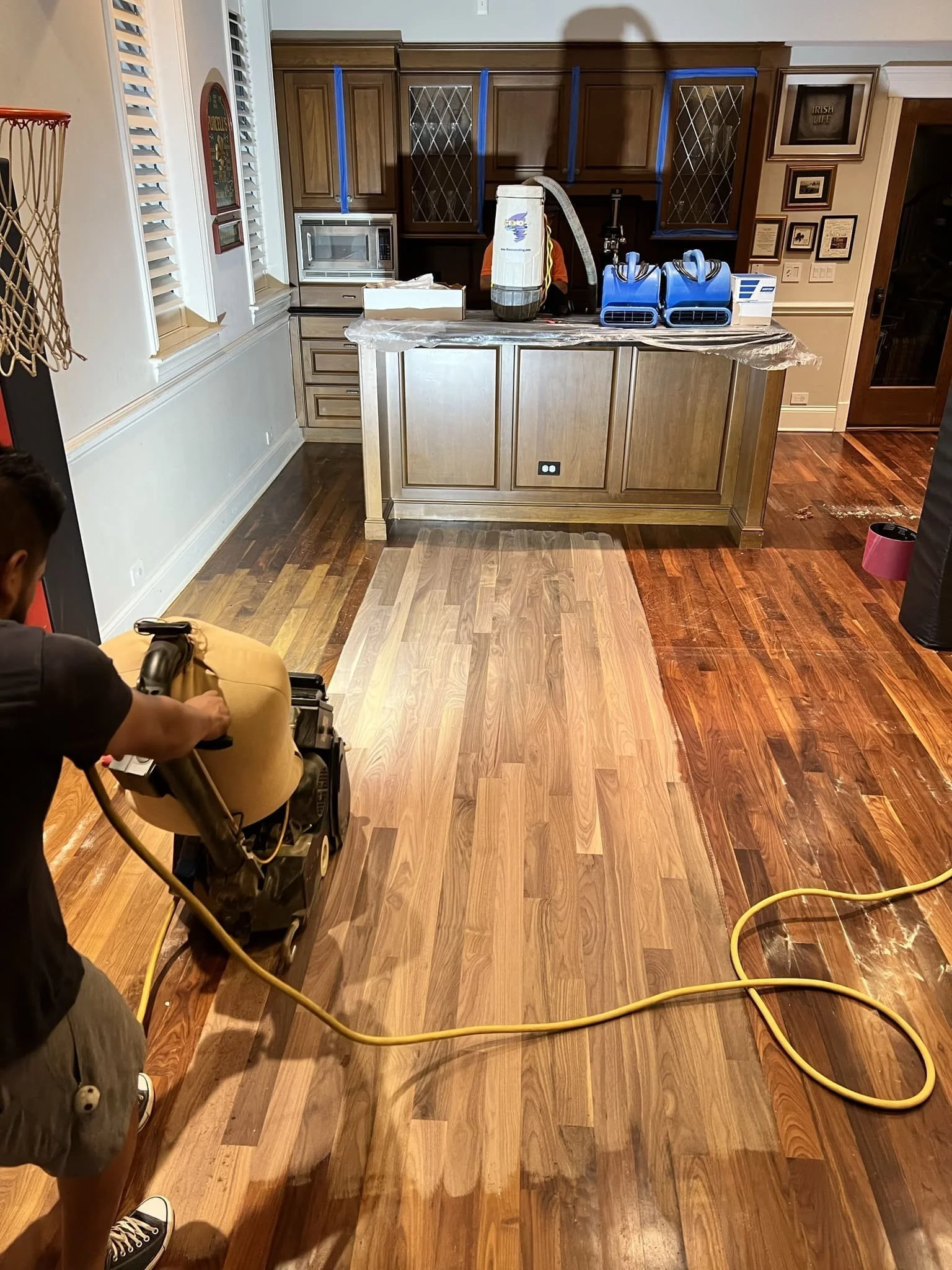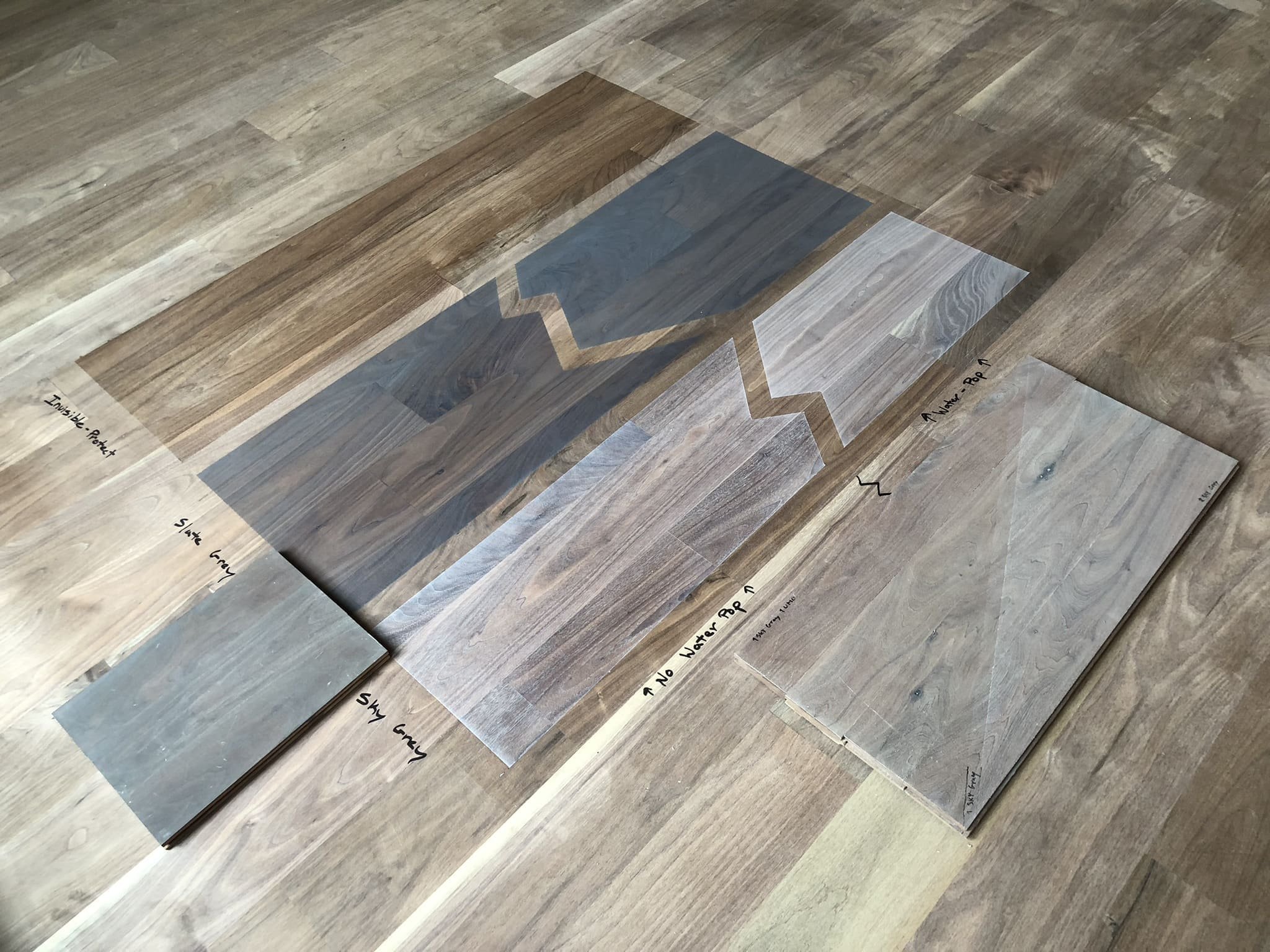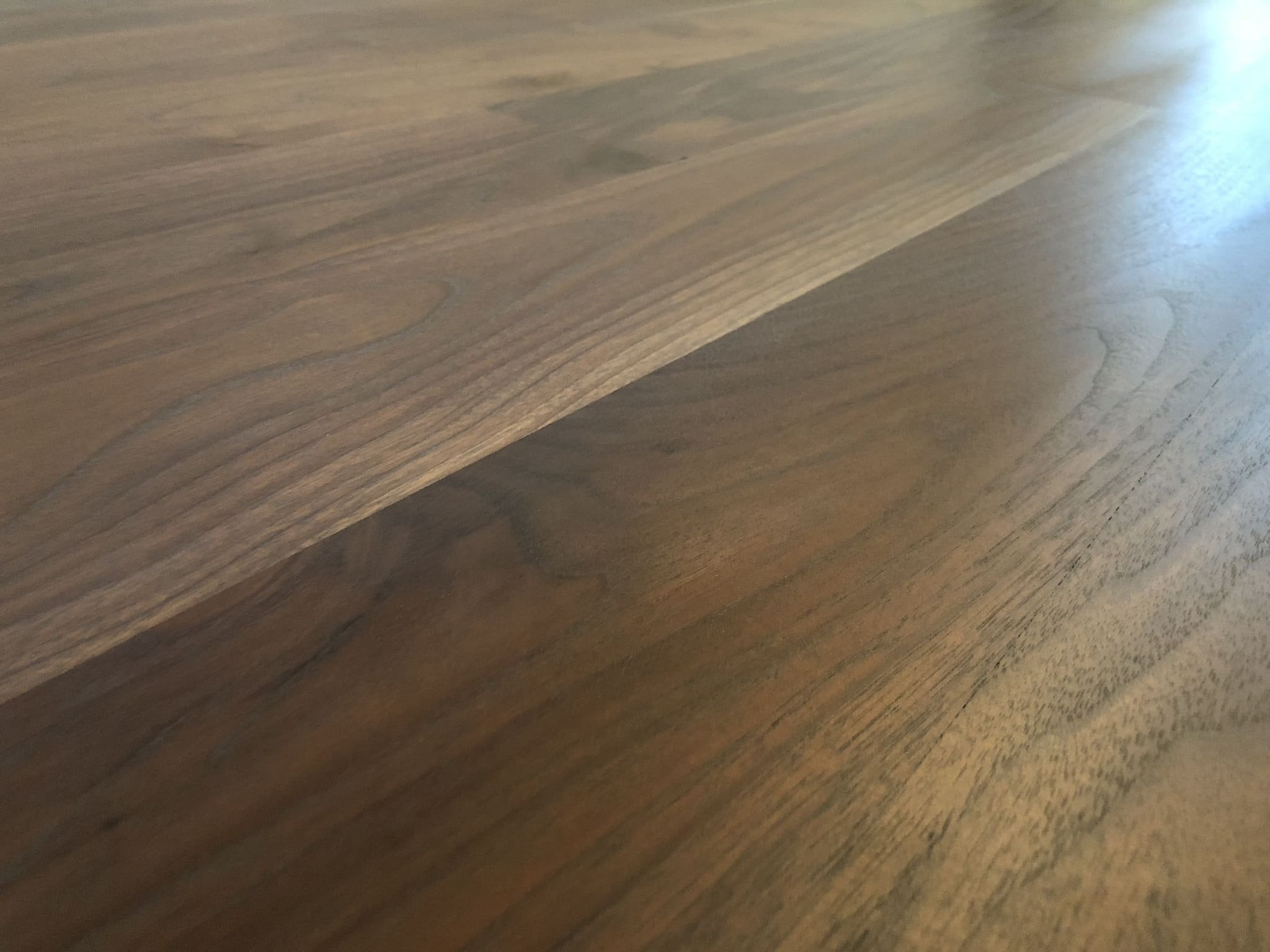Hey guys, Patrick here! Today is all about Walnut flooring. Walnut floors are undoubtedly a stunning addition to any home, but how do you ensure they stay that way for years to come? The secret lies in choosing the perfect finish. With the right finish, you’ll protect your floors and enhance their natural beauty, ensuring that they remain a focal point of your home. If you aren’t sure about what kind of wooden floors you have in your home, or what kind of wooden floors you want in your home, check out my other blog post which will help you narrow it down!
From understanding the unique characteristics of walnut floors to exploring various types of finishes, we’ll guide you through the most important factors to consider and even provide our top recommendation for the best finish. Are you ready to unlock the secret to gorgeous, long-lasting walnut floors? Let’s go!
The first sanding pass on a walnut hardwood floor
Key Takeaways
Proper finishing is key to protecting your walnut floors, with oil-based polyurethane offering enhanced graining/knotting but higher VOC levels compared to water-based finishes.
We recommend Loba Water Based Finish due to its durability, scratch resistance & low VOCs, hire us or follow the correct application process yourself.
If you’re just here looking for the product, then here is an Amazon link to the best Loba water based finish that I recommend. If you are more interested in going with the less expensive oil-based alternative, here is a link to that one.
Understanding Walnut Floors
Walnut is a sought-after wood for flooring, known for its rich color and unique wood grain. But not all walnut floors are created equal. There are two main types of walnut flooring available: Brazilian and American Walnut, each with their distinct properties and benefits.
Finishing your walnut floors is a pivotal step in safeguarding them from daily wear and tear, including scratches, stains, and moisture damage. A properly applied finish can also enhance the natural beauty of walnut, showcasing its unique grain patterns and color variations. Let’s examine Brazilian and American Walnut in greater detail and understand the significance of selecting the right finish.
Brazilian Walnut vs. American Walnut
Brazilian Walnut, also known as Ipe wood, boasts impressive durability and longevity. With a Janka hardness rating of 3690, it is highly resistant to wear and damage, making it an excellent choice for flooring applications. On the other hand, American Walnut, often referred to as Black Walnut, has a lower Janka hardness rating of around 1010, meaning it’s softer and more prone to wear and damage compared to its Brazilian counterpart. Both types of walnut will require proper finishing to ensure their protection and longevity.
While Brazilian Walnut is denser and more durable, American Walnut offers a wider range of colors, from creamy white to dark brown, and is known for its stability and good shock resistance. Irrespective of the type of walnut flooring you opt for, selecting a suitable finish that enhances the wood’s natural attributes and provides sufficient protection against daily wear and tear is necessary.
Rubiomonocoat samples and finishes on an American Walnut floor
The Importance of Proper Finishing
A proper finish is the key to preserving the beauty and durability of your walnut floors. It not only protects the wood from damage but also enhances its aesthetics by bringing out the natural color and grain. A good finish also makes cleaning and maintenance easier, as it prevents dirt and spills from penetrating the wood surface.
There are various types of hardwood floor finish available, each with its own advantages and disadvantages. Some popular finishes for walnut floors include:
Oil-based polyurethane
Water-based polyurethane
Rubio Monocoat Wax
Other natural finishes
Evaluating the advantages and disadvantages of each type of finish coat, including their sheen levels, is necessary to determine which one will meet your needs and preferences best.
Types of Hardwood Floor Finishes
Oil-based and water-based polyurethane dominate as the most popular choices for residential hardwood floor finishes. Understanding the distinct advantages and disadvantages of each finish type is key before making a decision.
To aid your decision-making, let’s examine the primary types of hardwood floor finishes: oil-based polyurethane, water-based polyurethane, rubio monocoat hard wax oil.
Oil-Based Polyurethane
One quart of Duraseal oil based poly
Oil-based polyurethane is a popular finish made from drying oils like linseed oil, soya oil, or tung oil, combined with a resin. This type of finish provides a warm, amber hue and is known for its durability. However, it has a longer curing time, typically around 30 days, and emits higher levels of volatile organic compounds (VOCs) compared to water-based polyurethane. For a finish like this, it is never recommended to stay inside of your home when it is applied or drying.
Despite its longer curing time and higher VOC levels, oil-based polyurethane can provide a beautiful, durable finish for your walnut floors. It enhances the natural graining and knotting in hardwood planks and offers excellent scratch protection and elasticity. But it might be more susceptible to yellowing over time than water-based finishes, so consider these factors when deciding on what the best finish will be for your specific living situation.
Water-Based Polyurethane
Loba Invisible 2K Water-based Finish
Ah yes, my absolute favorite, Water-based polyurethane. It is an eco-friendly alternative to oil-based finishes an it offers several advantages:
It dries VERY quickly
It has low VOC levels
It forms a strong bond with the wood, making it resistant to scratches, stains, and fading
It provides a clear, natural look that complements walnut floors beautifully
It does not have the yellowing effect of oil-based polyurethane
Although water-based polyurethane may cost more than oil-based polyurethane, it comes with several benefits, such as quicker drying & curing time (around 5 hours) and reduced VOC levels. In my personal opinion this finish not only looks better than the other options, but it also performs much better. If you have a home with pets and children, or you need to be back in your home asap, this is definitely one of the best options available. The choice between oil-based and water-based polyurethane will ultimately depend on your individual needs and preferences.
Rubio Monocoat Hardwax and Other Natural Finishes
Rubio Monocoat Hardwax Oil Finish
Rubio Monocoat and other natural finishes, such as shellac and wax, offer a low-sheen, natural look for your walnut floors. They can enhance the wood’s natural appearance but may not be as durable as oil-based or water-based polyurethane finishes. Over the years, I’ve applied a ton of this finish to floors.
These finishes typically require more work to apply and more maintenance. With Rubio Monocoat, you will need to have it re-waxed and re-applied every three to six years. These are very high end designer finishes and they are going to be by far your most expensive option. The re-application process works a lot like a buff & recoat, the floors will NOT need to be sanded back down to raw wood for a maintenance rewaxing.
While these finishes may not offer the same level of durability to spills and chemicals as a water based finish, they tend to have better scratch resistance because of the low sheen layer. If you have the budget for this option, I actually highly recommend it. The colors that Rubio Monocoat has are unmatched by any other manufacturer in our industry. Also, in my professional opinion, the way the floors physically look when they are finished with Rubio is incredibly unique, and truly stunning.
Factors to Consider When Choosing a Finish
Rubio Monocoat samples on a walnut floor
Selecting the best finish for your walnut floors involves considering factors like durability, aesthetics, and environmental impact. Each finish type comes with its unique set of advantages and disadvantages as we went over, so careful consideration of your options is necessary to choose the finish that fits your needs and lifestyle best.
Consider the purpose of the room, the amount of foot traffic the floor will endure, and your personal preferences for the floor’s appearance. For most customers, I think it mainly boils down to the extra pricing of these finishes as the final deciding factor. Assessing all of these options can aid you in making a sound decision about the best finish for you.
Durability and Maintenance
When choosing a finish for your hardwood floors, durability is a key consideration. A durable finish will protect your floors from:
Everyday wear and tear
Scratches
Stains
Discoloration
However, it is also important to note that wooden floors are not tile or concrete. They can not withstand as much traffic or force as stone can. I always tell my clients to have realistic expectations when it comes to wear and tear on your floors.
Maintenance also plays a significant role. Different finishes may require varying levels of care and upkeep, so it’s critical to choose a finish that aligns with your lifestyle and cleaning habits. For instance, oil-based and water-based polyurethane finishes are sturdy and low-maintenance, while wax finishes might require more upkeep to maintain their appearance. Opt for a finish that provides an optimal balance of durability and maintenance for your requirements.
Aesthetics and Wood Grain Enhancement
The finish you choose can also have a significant impact on the appearance of your walnut floors. Different finishes can bring out different features of the walnut, such as enhancing the warm hues or giving the wood a glossy shine.
Think about how the finish will accentuate the wood grain and improve the overall aesthetics of your walnut floors. You may prefer a clear finish that highlights the natural beauty of the wood, or a warm, amber hue that enhances the wood’s depth and richness. By taking aesthetics into account, you can ensure that your chosen finish will enhance the overall look and feel of your walnut floors.
Lately, the trend has been very matte floors. Most customers don’t even want to look at samples of shiny finishes anymore. And I whole heartedly agree with them. The lower the sheen of the finish that you choose, the more beautiful the flooring project will turn out, in my opinion.
Walnut floor finished with Loba Invisible
Environmental Impact and VOCs
Considering the environmental impact and the levels of volatile organic compounds (VOCs) in the finish is also important when making a decision like this. VOCs are carbon-containing chemicals that evaporate easily at room temperature and can affect indoor air quality.
Oil-based polyurethane finishes generally contain higher VOC levels than water-based finishes, potentially leading to increased indoor air pollution and potential health risks. Consider the VOC content and the possible environmental impact of the finish on your home and the environment when choosing a finish. Additionally, using mineral spirits for cleaning up oil-based finishes is a common practice.
Our Recommendation: Loba Water-Based Finish or Rubio monocoat
Based on my knowledge and experience, I highly suggest either the Loba water-based finish or Rubio Monocoat for your walnut floors. Loba’s 2K InvisibleProtect is an excellent choice for its durability, scratch resistance, and protection against wear and tear. However, Rubio Monocoat is also an excellent choice for it’s very unique looks and special colors. Both finishes do a great job of protecting the natural beauty of the wood while still offering excellent protection from scratches. The Loba will give you more chemical resistance to spills, however the Rubio will give you better scratch protection but will require more maintenance later down the road.
Both of these options also have low VOC levels, marking them as an eco-friendly choice. With their numerous advantages and suitability for walnut floors, it is tough to choose the better finish out of these two. But if I had to choose, for most clients, the Loba water-based finish would be my top recommendation for the best finish to use, not just on your walnut floors, but on any hardwood floors.
Application Process and Tips
Adhering to the correct application process and tips will ensure a successful and long-lasting finish using Loba water-based finish. Begin by sanding the floor to prepare the surface for the finish.
Before applying the finish, ensure that the temperature and humidity are within the ideal range, with a temperature of 68°F (20°C) and a humidity level of 45-55%. Always make sure to use a roller that is acceptable for water-based finish. It must be microfiber, these are the ones we usually use. Wait at least 24-48 hours after applying the finish before placing furniture on the floors to ensure that the finish is fully cured.
Applying the final coat of Loba water based finish
Hiring Flooring Professionals
While you can apply a finish to your walnut floors yourself, hiring a flooring professional can guarantee optimal results for your project. Flooring professionals have the experience, knowledge, and tools necessary to properly install and finish your walnut floors, helping you avoid potential mistakes and ensuring a beautiful, long-lasting result.
When choosing a flooring professional, it is important to:
Do research
Check social media for pictures of their work
Check credentials and licenses
Review contracts and invoices
Undertaking due diligence can help you ensure that you’re collaborating with a competent and reputable contractor who can help you attain the best outcome for your walnut floors.
Questions to Ask Your Contractor
Before engaging a contractor, inquire about their experience, the products they use, and their suggestions for your particular flooring needs. Inquire about their equipment, and ask to see a portfolio of their past projects. Additionally, verify that they are licensed and insured to perform the type of work required for your project.
Asking pertinent questions and collecting information about your potential contractor can help you make a well-informed decision about whom to hire for your floor finishing project.
DIY vs. Hiring a Professional
When deciding whether to handle your walnut floor finishing project yourself or to hire a professional, consider the advantages and disadvantages of each option. DIY can save you money and provide a sense of accomplishment but may also result in accidental damage to the hardwood or a less-than-professional finish. On the other hand, hiring a professional can ensure better results, quicker and more efficient work, and increased home value, but may come at a higher cost.
Take into account factors like your experience, skill level, and the complexity of the project. Keep in mind you will need to rent very specialized equipment in order to do this properly. Walnut, even for professionals, tends to be a very difficult wood to sand correctly. Ultimately, the decision between DIY and hiring a professional will depend on your individual needs, preferences, and budget.
Caring for Your Walnut Floors
Appropriate care and maintenance are key to maintaining the beauty and longevity of your walnut floors. Frequent cleaning and maintenance not only maintain your floors’ appearance but also protect them from dirt and debris that can scratch and erode the floor finish.
Setting up a regular cleaning routine and implementing preventive measures, like using protective pads on furniture and avoiding too much moisture, will help ensure that your walnut floors continue to enhance your home’s beauty for years.
Cleaning Routine
To preserve the beauty and durability of your walnut floors, implement a regular cleaning routine that involves:
Daily sweeping or dusting to eliminate dirt and debris
Spot cleaning spills immediately to prevent stains and damage
Vacuuming every few days to remove additional dirt and dust
Using a damp mop with a soft terry cloth head or a special cleaning mop designed for hardwood floors when needed
Utilizing mild cleaning solutions, like Bona Hardwood Floor Cleaner or a homemade mix of white vinegar and water, can help maintain your floors’ appearance without causing harm. By following a consistent cleaning routine, you’ll protect your walnut floors and ensure they stay looking their best for years to come. If you want to dive a little deeper into the cleaning process and have more questions, check back into my blog in a month as I’ll have a new, very detailed, blog post about it.
Preventing Damage
Besides regular cleaning, you can take several steps to safeguard your walnut floors from damage. Position protective pads or glides under furniture to shield the floors from scuffs and scratches, and (for the love of God) please refrain from dancing or walking in stilettos & high-heeled shoes which can cause dents.
Be mindful of moisture, as excessive moisture can cause damage to walnut floors, such as warping, buckling, or swelling. Place walk-off mats at entrances to help minimize the amount of abrasive dirt and debris that can be brought in onto the floor. By taking these precautions, you can help preserve the beauty and longevity of your walnut floors.
Concluding Thoughts
In conclusion, choosing the perfect finish for your walnut floors is essential for protecting them and enhancing their natural beauty. By understanding the unique characteristics of walnut floors, exploring various types of finishes, and considering factors such as durability, aesthetics, and environmental impact, you can make an informed decision about the best finish for your needs.
With my recommendation of Loba water-based finish and the guidance provided in this blog post, you’re now equipped to choose the ideal finish for your walnut floors! I hope this info helped shine some light on all the different types of finishes that are available for not just Walnut floors, but all hardwood floors.
I hope you enjoyed reading my blog post. I’ve been doing my very best to get new blog posts for you guys and I’ve got a whole heck of a lot more coming. Stay tuned. And as always, reach out to us if you need your floors done!
Up close of a walnut floor fully finished with Rubio Monocoat
Frequently Asked Questions
What is the best Stain for walnut flooring?
Oil-based stains are the best choice for black walnut flooring due to their deep pigments; use a brush, cloth or rag to apply it following the grain of the wood. Wipe it dry once applied.
Should I stain walnut floors?
If you like the natural look of walnut, it's best not to stain it. The colors and texture will stand out well on their own, creating a classic wood look.
How do you make walnut floors shine?
Restore your walnut floor's natural shine by having a simple Buffing & Recoating process completed on the floors. Apply a new coat of finish and the sheen level of the floors will entirely be restored.
What is the difference between Brazilian and American Walnut flooring?
Brazilian Walnut is denser and more durable with a higher Janka hardness rating, while American Walnut offers a wider range of colors and better shock resistance.
Which type of finish is more durable, oil-based or water-based polyurethane?
Water-based polyurethane is generally considered more durable than oil-based polyurethane, as it is better able to withstand dents and other damage. Previously, this used to be reversed. But the water-based products have seen exponential improvement in our industry.










